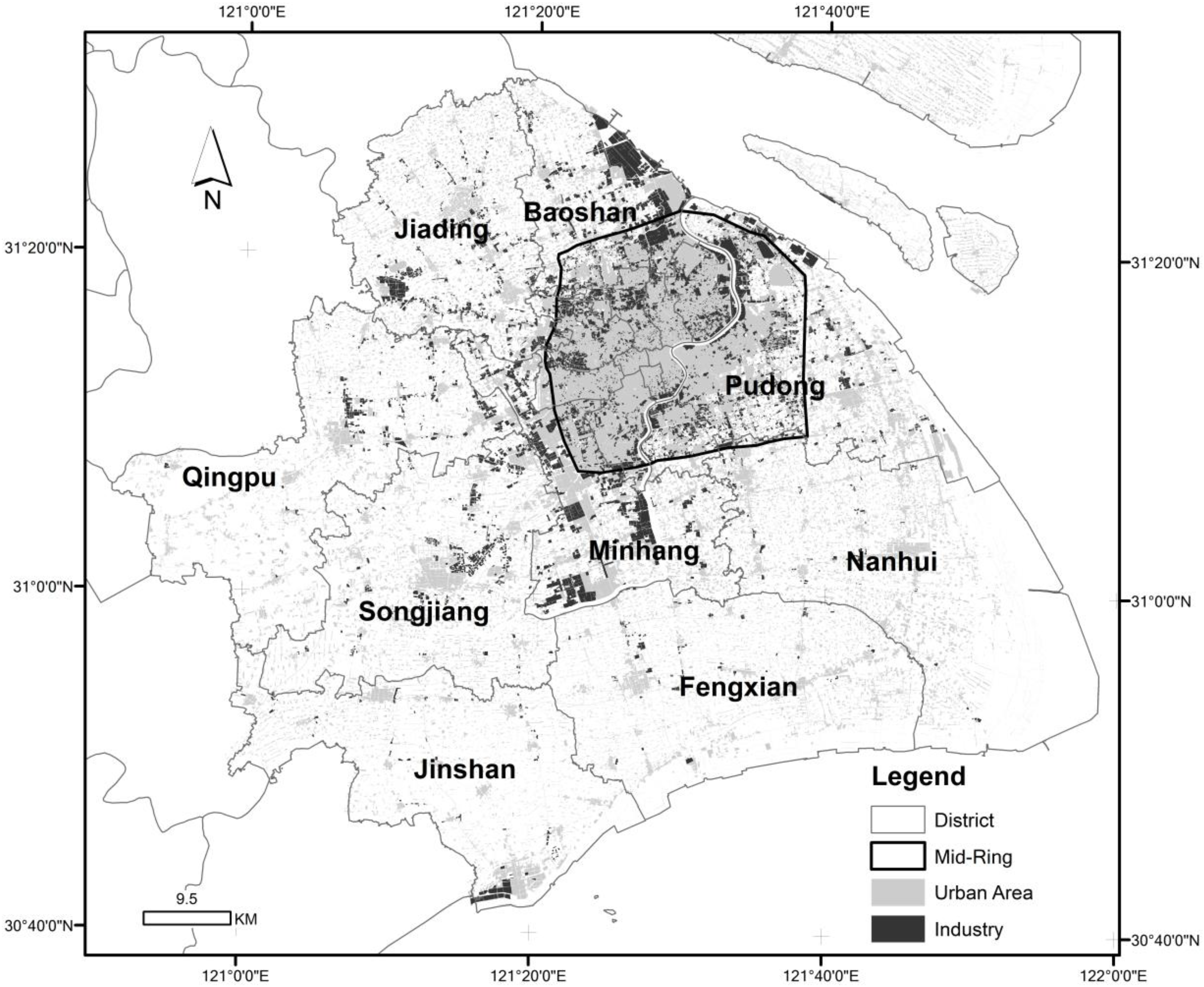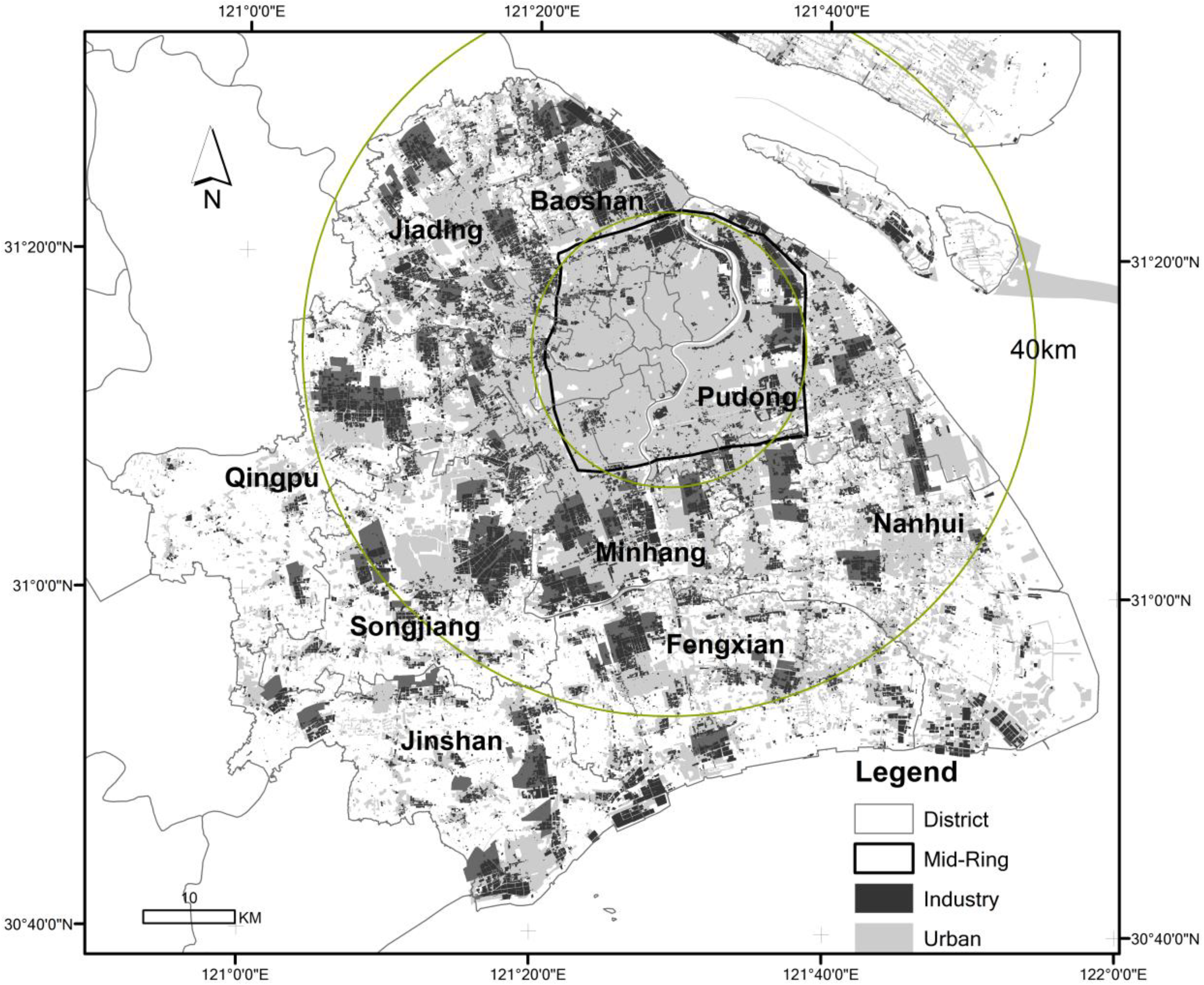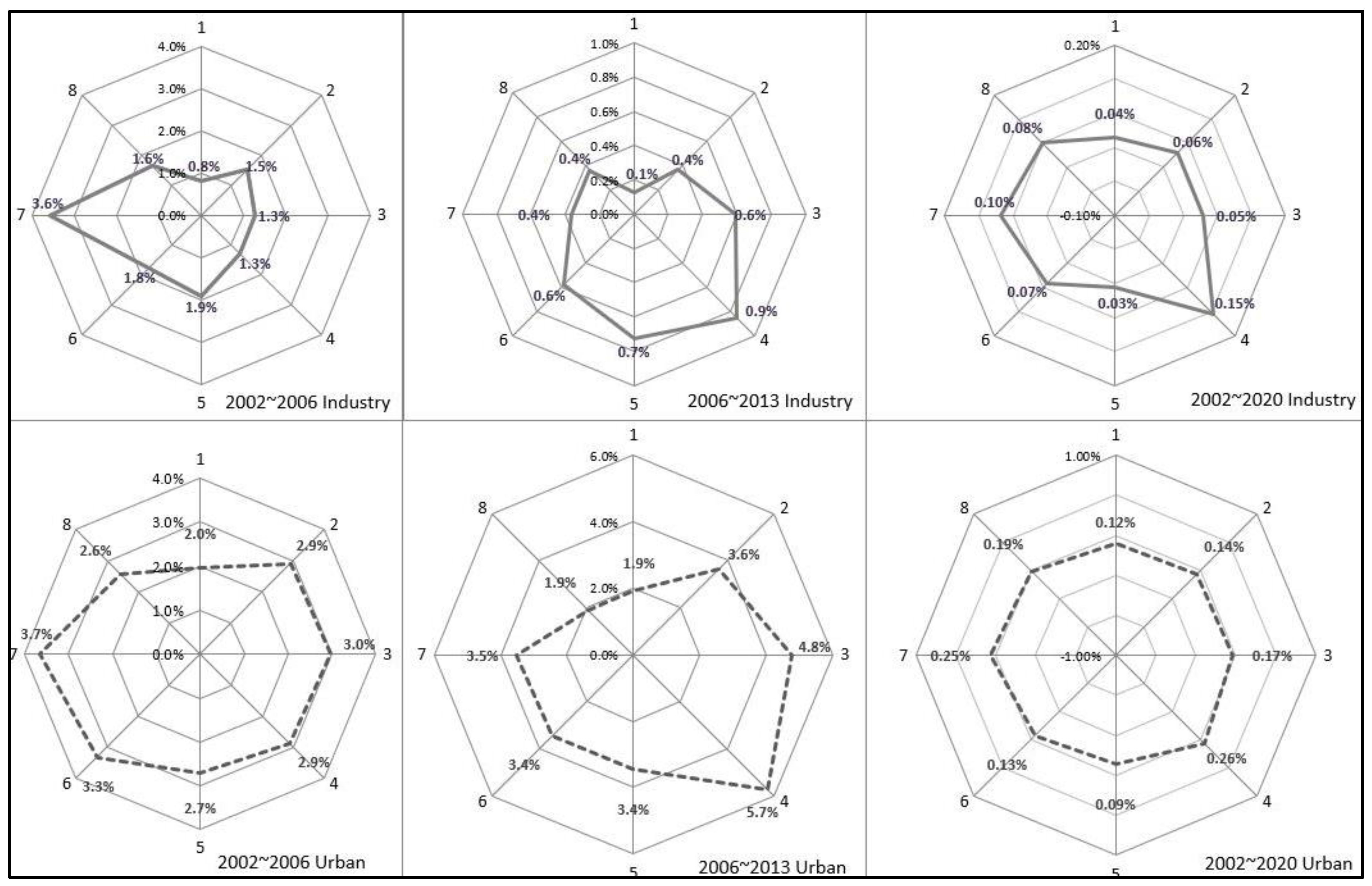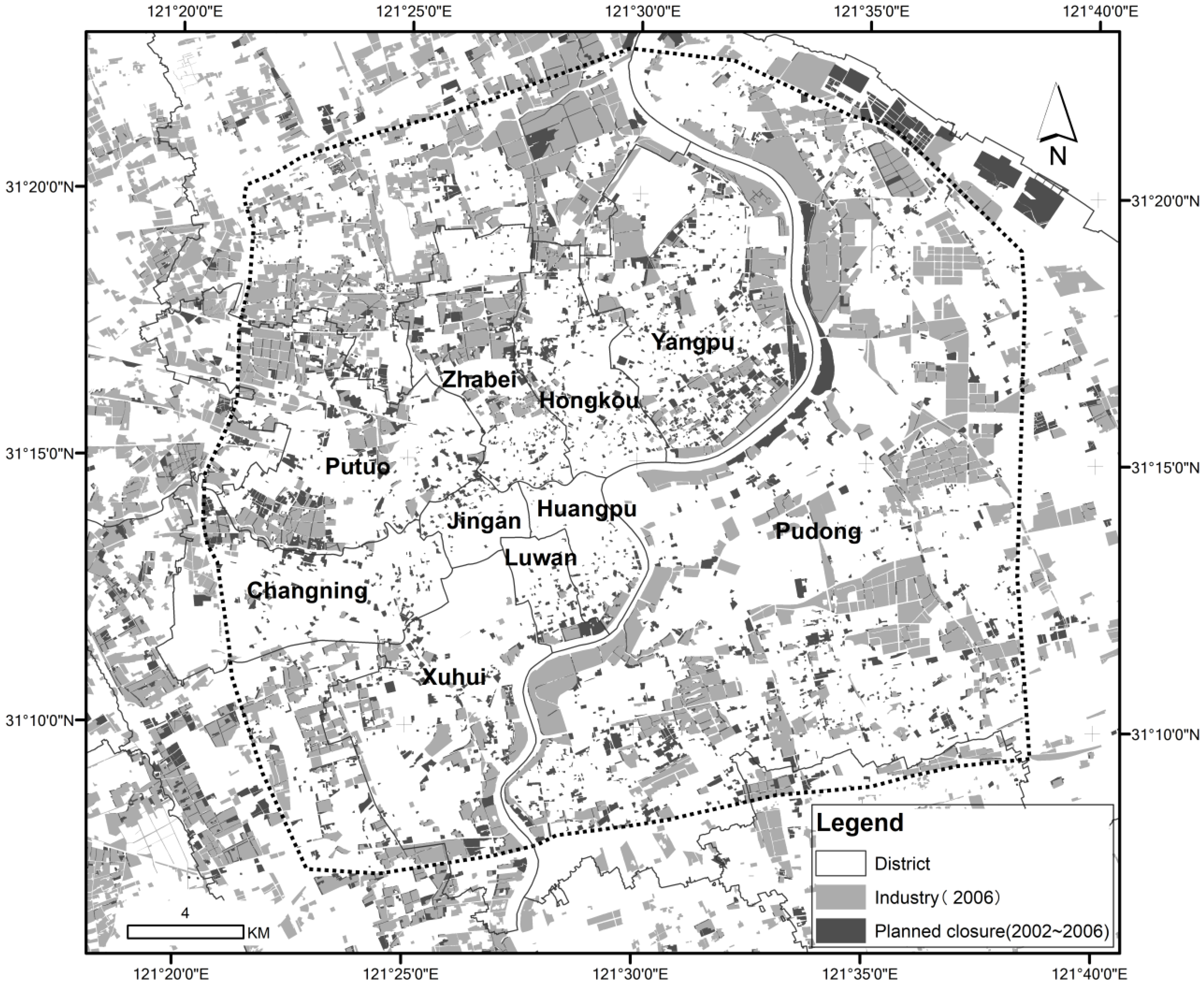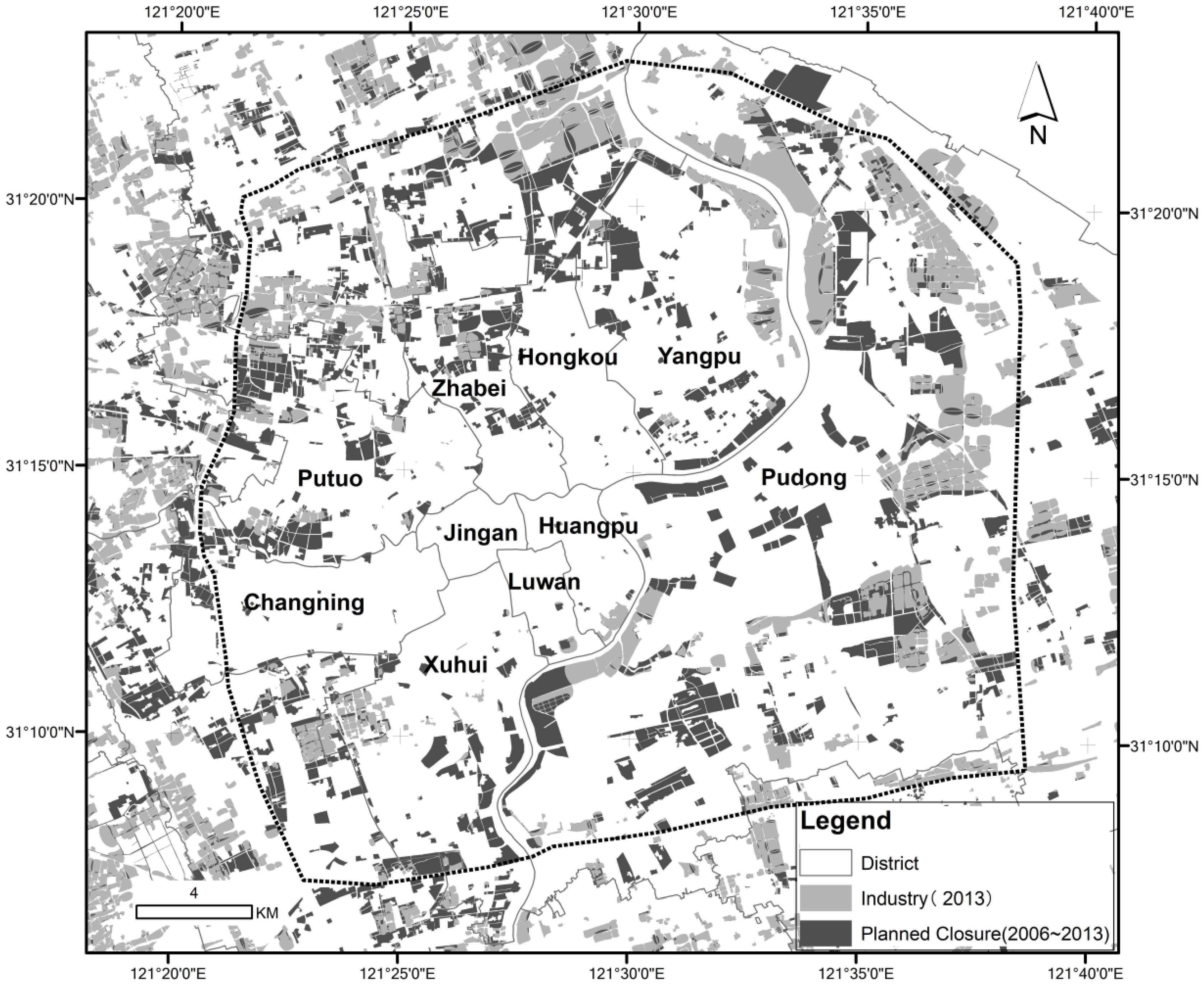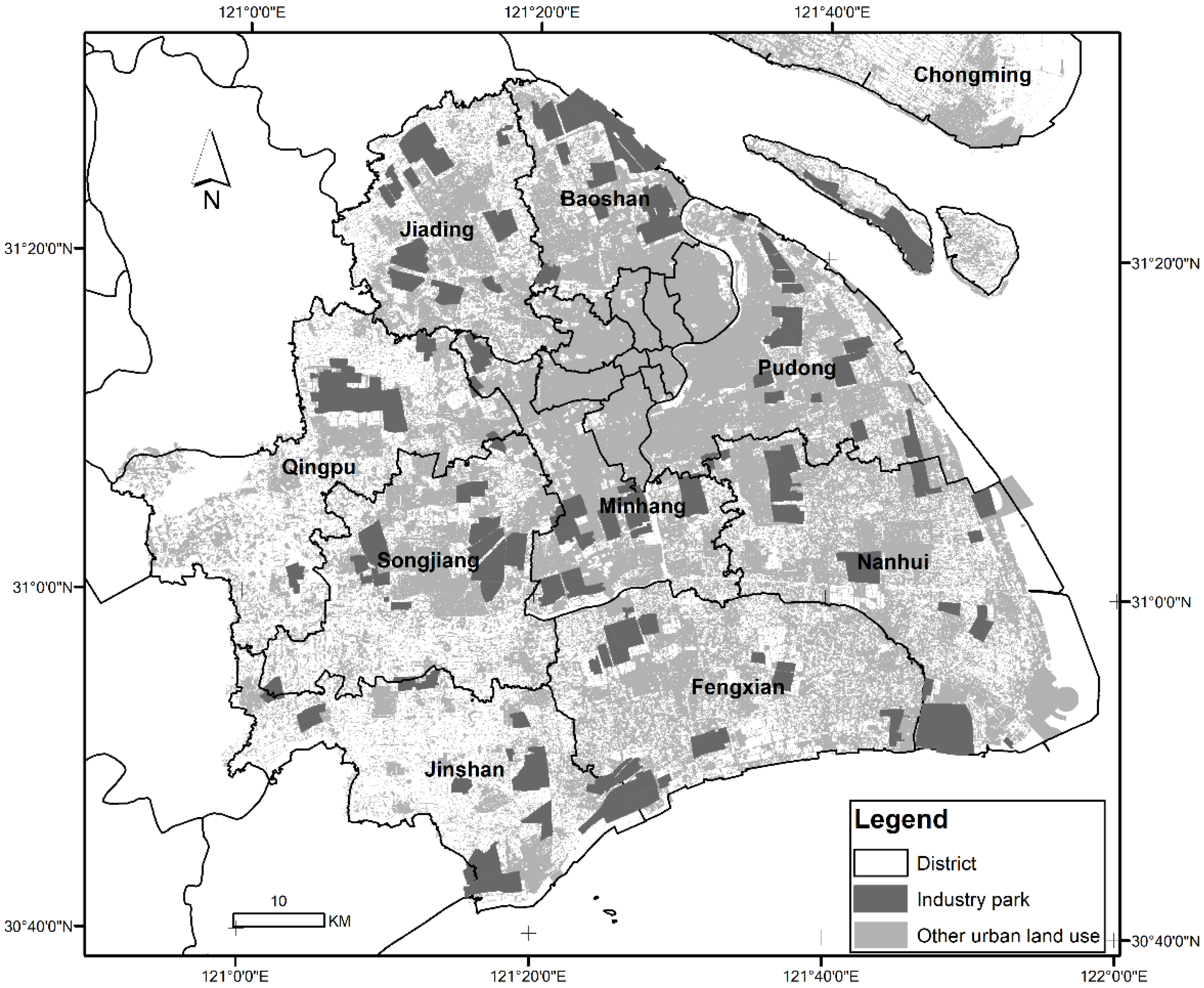1. Introduction
Suburbanization describes the growth and spatial reorganization of a contemporary city. It indicates that the urban population, dwelling places, and commercial and industrial activities in the central area of a city have started to relocate to surrounding areas, facilitated by the improvement of urban infrastructure [
1,
2,
3]. Industrial land suburbanization delineates the process of existing industrial factories relocating from the central area of a city to suburban areas, which leads to shrinking industrial land use in the central area and the growth of industrial land use on the outskirts of a city.
The cause for existing industrial factory relocation can be the continuously increasing land price in the central area of a city, or the administration’s urban planning and city management needs. In a market economy, the urban land development process in a city is primarily regulated by this market competition mechanism. With a growing population and urban land use, the land around the city center becomes more and more scarce. Commercial and residential uses in inner cities outcompete and displace industrial land concentrically from inner cities outward [
2,
4]. The suburbanization of industrial land use speeds up the land use expansion of a city, which brings critical sustainability issues, such as the loss of prime agricultural farmland, heavy traffic congestion, and degraded quality of life [
5,
6,
7]. In China, for example, heavily concentrated manufacturing factories around city centers cause severe traffic congestion and air pollution, while unorderly industrial diffusion has dramatically accelerated the removal of prime agricultural land during the past three decades [
8,
9]. Therefore, local governments of these cities have tried to use urban planning and urban management tools to optimize urban land use by relocating the low efficiency and polluting industrial factories to designed industrial zones in suburban areas.
Industrial land revitalization illustrates redevelopment activities on previously industrial land. The relocation of industrial factories in the central areas of a city generates a significant amount of vacant land underutilization, which could cause an increase in crime rates and deterioration of living conditions [
10,
11,
12]. With the increasing land price in the city’s central areas, residential and commercial land developers want to rezone those areas for higher output value uses, which are generally supported by local governments because of higher revenue generation and improved livability of those areas [
13,
14].
In some cities, the suburbanization of industrial land happens in advance, and previous brownfield land is left vacant for many years before being redeveloped [
13,
14,
15]. Meanwhile, in other cities, the suburbanization and revitalization of industrial land happen simultaneously [
16,
17]. Either way, the transformation of the industrial spatial structure and urban land use expansion act as two close-knit processes, determining the spatial trajectory of urban transformation [
4,
18,
19,
20,
21]. While evolutionary economic geographers have explored evolving spatial structure and distribution of industries using theoretical frameworks based on the agglomeration effect, technology innovation, knowledge spillover, and industry life cycle theories [
22,
23,
24], most of them have only focused on industrial structure alone, neglecting urban spatial processes. There is a lack of exploration into how urban land use change is linked with the spatial evolution of industrial activities. Frenken and Boschma [
25] propose a theoretical framework to investigate industrial dynamics and urban growth, but no specific industrial space is presented or delineated, although such an understanding of spatial evolution is essential to urban planning and city management.
In addition to market forces, administration intervention also plays a critical role in a city’s land development processes [
26]. Nowadays, many cities worldwide are renovating their city centers by removing some of the low productive industrial plants and revitalizing the underutilized brownfield land in central areas. This process is more evident in China than in other countries, where planned economic growth dominates [
16].
Limited by the available tools, most Western cities focus on specific land parcels or small areas by improving urban designs. Great successes have been achieved by generating creative hubs and cultural centers in metropolitan areas [
12,
14,
15,
27,
28]. However, a systematic approach to showcasing how multiple urban management initiatives work together to create citywide momentum and change the overall urban form of a city is lacking. The revitalization processes of many cities have stagnated, and some of the suburbanized industrial lands also need to be revitalized [
29,
30]. Therefore, this study tries to illustrate how to improve land use efficiency and sustainability through urban industrial land spatial transformation and urban land use expansion co-evolution perspectives, by quantifying the vacant industrial land revitalization, industrial land consolidation, and industrial–residential land evolution. This study uses Shanghai, China, as a case study, and attempts to answer the following questions:
How does industrial land suburbanization impact the urban form geospatially?
What is the evolutionary path of urban land use transformation?
What are the tools that can be used for underutilized industrial land revitalization?
What are the challenges of underutilized industrial land revitalization?
What roles do local governments play in navigating the urban form transformation, to make it more sustainable?
To answer these questions, this study first combed through historical urban management policy and urban planning practice changes in Shanghai, and then used the land use change detection method to illustrate how policy change leads to urban form change. Finally, the paper summarizes the good practices and challenges the city has faced.
2. Literature Review
Suburbanization is closely related to urbanization, which is often defined by the proportion of the urban population migrating to suburban areas due to congestion and environmental degradation in urban centers [
31]. The term suburbanization first appeared in North America due to the movement of urban communities [
32,
33]. Unlike suburbanization in North America, most suburbanization in China is caused by rapid industrial land development and urban expansion [
34,
35].
Industrial land developments can bring significant economic benefits to suburban villages, including revitalizing deteriorated communities, providing new jobs, reducing risks to public health, etc. [
36]. Under the urbanization process in China, market-oriented reforms have fundamentally changed industrial land relocations. The housing and land system reform promotes industrial land development [
37]. Local governments were given greater decision-making power, and therefore local administrators competed to persuade industrial factories to relocate to their authorizations. The fast industrial land use growth in suburban areas boosted urban land use expansion. Studies found that industrial relocation in Shanghai’s suburbs led to economic growth [
38].
Local authorities have kept industrial land prices low to attract business investment for tax revenue and employment purposes. Rapid urban expansion and large-scale, low-cost industrial land supply led to inefficient land use [
39,
40,
41]. As many large cities in China are reaching the “ceiling” of the total construction land area, the demand for construction land for housing, public facilities, and green space continues to increase. This has drawn particular attention to large areas of inefficient industrial land use.
The land and resource management departments have long recognized these problems, and have adopted a series of policies to improve industrial land use efficiency and achieve a highly dynamic and environmentally sustainable system of industrial development [
42]. The policy goals of local government usually include addressing inner-city decline, reshaping the urban image, and improving urban competitiveness by planning specialized industrial parks, zones, and areas [
43]. These delineated urban development boundaries can be a public policy tool used to control the spatial distribution of urban spaces, improve the level of intensive land use, and protect the ecological environment of resources [
44].
Meanwhile, with the increasing demand for high-quality urban development, China’s metropolises have undergone a profound transformation from traditional manufacturing to financial and business services [
45]. From a capital perspective, the main driver for industrial land relocation is to obtain a sufficient “land rent gap” [
46]. Industrial land relocation occurs as the land rent gap attracts investment and addresses development costs and risks. From the demand perspective, changes in the consumption, culture, and lifestyle of the middle class are vital forces in promoting industrial land relocation [
47].
Under 40 years of rapid development, numerous megacities in China, such as Beijing, Shanghai, and Guangzhou, have entered the post-industrial era, and the industrial land of these cities has updated from manufacturing industries to service industries [
48]. Meanwhile, in China, most of the vacant, efficiently utilized industrial sites have complex building environments or serious safety issues, such as building safety or fire safety problems, which can only be solved through redevelopment [
49,
50,
51].
The existing literature provides various explanations of the mechanisms of industrial land relocation. However, due to a lack of reliable data sources, the amount of industrial land conversion and its main drivers remain ambiguous. Using a spatial perspective to address these gaps and study the transformation of industrial land in Chinese megacities is essential for assessing the spatial effects of industrial land relocation. The following section uses Shanghai as an example to illustrate the unique industrial land use evolution process in China.
3. Materials and Methods
Shanghai is located at the tip of the Yangtze River Delta. The city of Shanghai covers a land area of 6396 km
2 and is the largest city in China by population, according to the 2019 census. To build the timeline of the policy changes of the city, this study collected the historical land use master plans since 1949, important government official land use and land planning policy documents since 1949, and some of the key project reports, such as the Shanghai Daning City project description and No. 8 Bridge Redevelopment project report. Most of the documents came from the published official documents library of the City of Shanghai. To quantify the scales of land use composition transformation, the study collected historical land use data from the planned land use maps (1982, 2013), land use surveys (2002 and 2006), Landsat remote sensing images (2009, 2013, and 2020), and local land use base (agricultural land inventory 2016 and land use 2020). The data processing and analysis approaches are illustrated in
Figure 1. The historical land use and land use planning data came from the Shanghai Land Use and Urban Planning Bureau. The Landsat remote sensing image data were obtained from
https://landsat.gsfc.nasa.gov/data/ (accessed on 15 March 2021). ENVI Image Processing Software was used to classify the land uses.
For the policy, project, and planning documents, this study used the thematic analysis method to chronicle the fundamental policy changes and then grouped them into periods by referencing the major policy shift points. A detailed policy application analysis was carried out for each of the periods.
We then built a geospatial database using ESRI ArcGIS software and recategorized the land use type of each year to make all the land use data comparable. The geospatial change detection method was then used to generate the land use change maps between identified periods. An expansion index was then developed to measure the land use expansion among different periods.
4. The Suburbanization of Industrial Land Use in Shanghai
The Shanghai government’s policy on relocating industrial enterprises to the suburbs differed before 1988 and after 1988 [
52]. Before 1988, the government’s policy was to establish suburban industrial zones and industrial satellite towns; that is, to open new industrial land in the suburbs. After 1988, in addition to improving and building new suburban industrial bases, the government began to rectify industrial enterprises in the central area in a planned way. The development of new industrial land in the suburbs was combined with the planned reduction of industrial land in central areas. Policy changes significantly impacted the intensity of industrial relocation, with entirely different consequences. Therefore, this study illustrates the industrial land suburbanization in different eras by referencing some significant policy changes.
4.1. Industrial Land Development before 1988
Before the founding of the People’s Republic of China, Shanghai was already overcrowded. By 1949, Shanghai’s per capita living area was 3.9 square meters, and the living conditions were deplorable. Around 13.7% of houses were shanties, dilapidated and simple structured dwellings. Most of the industrial neighborhoods were gathered along the Huangpu River and the Wusong River, and the Suzhou River that crosses the central area (
Figure 2), causing industrial buildings and residential buildings to compete for land, industrial transportation and citizen travel to compete for roads, and industrial production and residents to compete for water supplies and power supplies. Therefore, after the founding of the People’s Republic of China, the newly established Shanghai government began to tackle the problem of suburban industrial relocation and formulated various policies and measures for this purpose, trying to use administrative power to lead industrial enterprises to relocate to suburban areas. In 1957, the Second Party Congress in Shanghai decided to “build satellite towns around Shanghai and disperse some industrial enterprises”, and proposed establishing the Wujiaochang, Pengpu, Taopu, Beixinjing, Caohejing and Gaoqiao industrial centers in the suburbs. The plan also included the construction of the five satellite cities of Minhang, Wujing, Anting, Jiading, and Songjiang. These citywide strategies and policies were reflected in the “Shanghai Urban Master Plan Draft” and “Preliminary Opinions on the Shanghai Urban Master Plan”, which were put into effect in 1958, and this pattern continued until the beginning of reform and opening up in the 1980s.
4.2. Industrial Land Development between 1988 and 2002
The Shanghai government implemented a planned relocation of industrial enterprises in the central areas, which began in 1988. In 1987, the Shanghai government convened an urban–rural industry coordination conference, proposing to speed up the diffusion and integration of urban migrant workers to the suburbs in a planned way, aiming to create a good production and living environment for the relaxation and expansion of relocated industrial enterprises that were too concentrated in the central city. From 1988 to 1994, the relocation of industrial enterprises was for the purposes of environmental governance and the relocation of polluting enterprises; after 1994, the purpose of relocation of industrial enterprises was to adjust the layout of urban functions, and relocate enterprises with low land productivity (
Figure 3).
The scope and quantity of industrial land in the built-up suburban area of Shanghai during this period began to grow rapidly and extensively with the expansion of the built-up area (
Figure 3). The speed of development and change provided the possibility and necessity of the suburbanization of Shanghai’s industry, driving the geographical redistribution of Shanghai’s social-economic activities.
The main reason for this distribution pattern was the adjustment of the industrial structure of Shanghai’s industry itself. Before the 1990s, Shanghai became one of China’s most important industrial bases. A complete industrial production system with an appropriate light-to-weight ratio and a complete variety was established, mainly in the raw materials industry, equipment industry, and consumer goods industry. Since the 1990s, the rapid rise of similar products in other cities across the country and the untimely updating of Shanghai’s products have caused the product market to shrink, and many industrial enterprises have experienced product backlogs or even losses. In the early 1990s, Shanghai’s industry began to adjust the industrial structure in response to these problems. On the one hand, it compressed the production scale of traditional industries and guided product upgrades; industries such as computers, medical biology, electronic information, and others were striving to complete the transformation and upgrade of the industrial system. The Shanghai government seized this opportunity to open new industrial parks in the suburbs and, at the same time, completed a spatial transfer of the input points of production materials, pointing the main development direction of industry to the periphery of the city. Therefore, it can be said that the upgrade of Shanghai’s industrial structure in the 1990s, which involved the expansion of Shanghai’s industrial layout to the periphery, was a fundamental reason for suburbanization.
4.3. Industrial Land Development between 2002 and 2009
In 2002, the industrial land in the inner ring dropped sharply compared to before 2000 (
Figure 4). The industrial land use around 2002 was mainly clustered around the city center and nearby districts, such as Baoshan, Yangpu, Hongkou, Zhabei, Putuo, Changning, Xuhui, and Minhang. The main reason for this is that before the 1990s, Shanghai’s urban development policy focused on industrial investment, compressing investment in urban construction and consumer projects, resulting in a severe lag in the development of Shanghai’s urban tertiary industry compared with the highly concentrated industrial production scale. The geographical agglomeration of production items did not bring about the agglomeration of consumption items, and urban production was unable to enter a virtuous circle in which the two effects would alternate. In the 1990s, the lag of the tertiary industry brought about tremendous obstacles to Shanghai’s urban production.
Therefore, the Shanghai government proposed the urban development strategy of suppressing the second industry and developing the third (“Retreat the Second and Enter the Third”). Using change to land use rights as a tool, the city promoted the relocation, closure, merger, and adjustment of about 700 factories in the inner ring, involving 450 industrial enterprises, freeing up 3 million square meters of industrial land. The freed-up land provided opportunities for the development of tertiary industries, such as trade, housing, and office buildings, which optimized the industrial structure of the urban core area. Therefore, it can be said that the development strategy of “Retreat the Second and Move into the Third” is the direct reason for the relocation of industrial enterprises from the central area of Shanghai to the suburbs.
During this period, industrial land increased significantly in Pudong. Pudong has become an essential foothold for the development of industrial suburbanization, and the balanced development of both sides of the Pujiang River has begun to occur. The densely distributed industrial land area has expanded from the vicinity of the inner ring to the vast area between the inner and outer rings, and there is a clear tendency to expand beyond the outer ring. The phenomenon of industrial suburbanization is reflected in this period.
4.4. Industrial Land Development after 2009
Given the shortage of land in the central urban area and traffic congestion, with high-level policy guidance, the Shanghai government developed the “Thirteenth Five-Year Plan for Transformation and Upgrading of Shanghai’s Industrial Zones” in 2009 to promote industrial land use concentrated around the planned industrial blocks. This plan and corresponding implementation policies accelerated the suburbanization of industrial land use and brought industrial land use management into a new era.
From the 2020 industrial land use map, we can see that the industrial factories of the city are mainly located more than 15 km (outside of the mid-ring) from the city center. Most of them reside between 30 km to 40 km away, representing 54% of the industrial land use of the city (
Figure 5). The industrial land use of the central city decreased from 133 km
2 in 2002 to less than 80 km
2 in 2020. We can see that the west and north are the main urbanizing directions of the city, and the borders of these two directions are 40 km from the city center of Shanghai. This means that the factories in those areas need to move further across the boundary, if they want to achieve better profit margins. This has been proved by the continuously bulging industrial development in the neighboring cities, such as Kunshan, Taicang, and Suzhou. Take Kunshan as an example. It was a county before 1990, but has grown into a city of more than one million people during the last three decades. Kunshan’s total industrial output value in 2003 was only 106.7 billion RMB, but rose to 1028.4 billion RMB in 2021, expanding almost ten times since 2003.
5. The Impacts of Industrial Land Use Suburbanization
It can be argued that an appropriate and balanced urban industrial spatial structure is imperative for steady urban growth. During rapid urbanization and suburbanization, any ad hoc and unplanned spatial distribution and allocation of industries may bring about undesirable consequences, including high energy consumption and waste, excessive loss of prime agricultural farmland, heavy traffic congestion, and degraded quality of life [
5,
6]. In China, for example, heavily concentrated manufacturing factories around the city center have led to severe traffic congestion and air pollution, while unorderly industrial diffusion dramatically accelerated the removal of prime agricultural land during the past ten years [
8,
9]. Therefore, understanding the relationship between land use change and industrial spatial distribution and their co-evolutional processes can help urban planners and decision makers develop a more sustainable and livable city.
To analyze the impact of the expansion and suburbanization of industrial land use on the citywide urban form change, this study used the Urban Expansion Intensity Index to investigate the co-evolutionary process of industrial and residential land use [
53].
where
is the land use at time
;
is the land use at time
;
is the total land area; and
is the time interval.
This research took the zero point of the Shanghai local coordinate system as the center and divided the space into eight quadrants to measure the residential and industrial urban expansion intensity index. Considering the limits of the available data and the fastest industrial land use suburbanization occurring in the early 2000s, we focused on the period from 2002 to 2020.
Figure 6 shows that the seventh quadrant had the highest industrial land use EII, which was greater than 3.0% annually during the 2002 to 2006 period. The third, fourth, fifth, and sixth quadrants had higher industrial land use EII during the 2006 to 2013 period. Meanwhile, the sixth, seventh, and third quadrants had high residential land use EII, which was greater than 3.0% annually during the 2002 to 2006 period. The second, third, fourth, fifth, sixth, and seventh quadrants had high residential land use EII, whereas the third and fourth quadrants rose to almost 5% and 6%, separately, during the 2006 to 2013 period. Overall, from 2002 to 2020, the urban expansions were well balanced. The southwest quadrants had higher industrial land expansion rates than the other quadrants. This was caused by a large amount of non-urbanized land in the southwest direction of the city. The results indicate that residential land use expansion was relatively consistent with industrial land use expansion, which means industrial land development led to residential land development. This is in agreement with studies on other areas of the country [
54].
However, as shown in the charts, the industrial land use expansion slowed from 2006 to 2013, while the residential land use expansion maintained a higher expansion speed. As illustrated in the previous section, the city delineated 104 industrial blocks in 2009 and tried to constrain inefficient industrial land use expansion. Meanwhile, with the boom of tertiary industry and the rapid increase in population, the demand for non-industrial land in the city increased rapidly. The profit generated from residential or commercial uses exceeded the city’s industrial revenue by a considerable margin. This was particularly true for under-utilized industrial land in the city’s central areas. Therefore, how to increase the land use more efficiently and bring idle land to life became a central task for the city. The following section illustrates the city’s approaches to revitalizing underutilized industrial land.
6. Industrial Land Revitalization
6.1. Industrial Land Space Restructuring
Corresponding to the fast suburbanization process of industrial land use, the evacuated brownfield land in the city’s central areas became a hot spot for redevelopment. In general, the revitalization of industrial land in Shanghai has gone through three stages [
55]. The first stage (1990–2005) focused on renewing state-owned industrial land in the central urban areas. In 1998, the “Interim Regulations on the Management of Allocated Land Use Rights in the Reform of State-Owned Enterprises” opened the idea of revitalizing Shanghai’s industrial land. At this stage, many state-owned enterprises transferred their occupied industrial land through agreements to change the nature of the land for secondary development. Due to the loose control of the government at this time, the promotion of the revitalization of many industrial lands during this period lacked planning guidance, and the original landowners and developers mostly shared the value-added land benefits. The government did not profit during the change to land use rights. This directly led to the relatively slow relocation of industrial enterprises and industrial land redevelopment. During this period, the closures of low efficiency industrial factories were mainly located along the Huangpu River in the core area, Waigaoqiao area, and other small sites inside the mid-ring road (
Figure 7).
The second stage (2005–2015) was dominated by the adjustment of the industrial structure, the transformation and upgrade of the park, and the gradual tightening of construction land indicators in Shanghai. On the one hand, since the Ministry of Land and Resources promulgated the “Regulations on the Assignment of State-Owned Land Use Rights by Bidding, Auction, and Listing” in 2002, Shanghai has successively issued the “Interim Provisions on Strengthening the Planning and Management of Changed Land Use Properties in the Central City” and other regulations, requiring that the industrial land use must be changed through government repurchase and “bidding, auction and listing” transfers, and new construction, reconstruction, and expansion projects must be implemented strictly in accordance with the plan, which prevents the occupiers of the allocated land from changing the land property rights through low-cost changes profit. On the other hand, the functional orientation of Shanghai has gradually focused on tertiary industry-led producer services and high-tech industries, and the areas within the inner ring of the city have begun to implement the industrial adjustment strategy of “returning the second and moving into the third”, gradually leading to high energy consumption, industrial enterprises with poor efficiency, and severe pollution migration to industrial parks in suburban areas, such as Baoshan, Wusong, and Jinshan. Because of the centralized transfer of land use rights, the government took complete control of low-efficiency industrial land relocation and underutilized land intensification and redevelopment. A significant amount of industrial land in the city’s central area was changed to other uses (
Figure 8). There was minimal industrial land left in the core area of the city (Huangpu District, Jing’an District, Luwan District, and Changning District) at the end of this period.
The third stage (from 2015 to the present) was mainly focused on revitalizing the stock and secondary development. In 2009, Shanghai’s Industrial Land Layout Plan determined the “104 blocks”, “195 areas,” and “198 areas” of industrial land (
Figure 9). Among them, “104 blocks” is a concentrated construction area for advanced manufacturing, including 49 industrial parks, 16 industrial bases, and 39 urban industrial plots. The total area is around 764 km
2, almost 25% of the total land use of the city. The well-known blocks include Waigaoqiao, Jinqiao, and Zhangjiang national industrial parks. “195 area” refers to the existing industrial land outside the planned industrial block and in the concentrated construction area, named after the actual area of about 195 km
2. It is mainly planned for urban commercial and residential land. “198 area” refers to the existing industrial land outside the planned industrial area and the planned centralized construction area, with an area of about 198 km
2. It is mainly intended for relocation and concentration of township industrial parks.
The “104” industrial block focuses on space optimization, structural adjustment, performance improvement, and energy level improvement, and strives to build a new industrial system led by strategic emerging industries, supported by advanced manufacturing, and coordinated with producer services, through consolidating and upgrading industrial parks. The advantages of industrial agglomeration enhance the comprehensive functions of the city. The “195 area” promotes the overall transformation of the stock industrial land, and the transformation direction focuses on research and development land, residential land, public service land, and public green space, or carries out sporadic development pilot work to promote the revitalization and utilization of the stock industrial land. There is a need to establish and improve the identification standards for low-efficiency industrial land, conduct a comprehensive investigation and classification evaluation, and promote the redevelopment and utilization of low-efficiency land. In the “198 area”, the intention is to vigorously promote the reduction of the current low-efficiency industrial land.
6.2. Industrial Land Revitalization
Beyond industrial land consolidation, Shanghai has adopted various modes of promoting the revitalization of industrial land. These modes are mainly based on the abandoned industrial land in urban centers, low-efficiency land in industrial parks, and scattered industrial land in suburban towns.
Abandoned industrial land in the city center is often owned by state-owned enterprises, and the land value is relatively high, but the plots are relatively scattered. One of the options to redevelop this type of land is to build creative industry parks. Many small industrial lands in the central area have been built up by developing innovative industrial parks and creative industries, without changing the building structure and increasing the building area. Creative parks such as Tianzifang and its adjacent No. 8 Bridge were rebuilt from old industrial plants, and formed a large-scale creative industry. The other option for this type of land is to redevelop it into mixed uses. In this case, state-owned industrial enterprises generally develop jointly with real estate enterprises. For example, Shanghai Electric Group, Shanghai Construction Real Estate, and Suhewan Holding in Zhabei District jointly developed the Shanghai Daning City project in Jing’an District.
The industrial land plots in the industrial park are relatively regular, and owned mainly by development zones or private enterprises. Shanghai mainly adopted three modes for developing inefficient land in industrial parks: change of property rights, through transfer of industrial land to more efficient land use entities through government repurchase or corporate sublease; industrial upgrading; and integration of industry and the city.
The spatial distribution of industrial land in suburban towns is often scattered. The “Thirteenth Five-Year Plan for Transformation and Upgrading of Shanghai’s Industrial Zones” puts forward the management strategies of “104 blocks”, “195 area”, and “198 area”, focusing on the low-efficiency industrial land for reduction, relocation, or clearance. For example, Shanghai Jinqiao Industrial Park develops and utilizes idle factory buildings of the original low-efficiency and disadvantaged enterprises, revitalizing the scattered factory area, and has so far introduced 24 new enterprises into the park.
6.3. Results
Although Shanghai has successively issued relevant policies to promote the revitalization of industrial land in recent years, there remains no clear definition of the legal basis for land use, including assignment, use, and transfer. Due to the unclear definition of land authority and ownership of interests, the government’s interests, parks, enterprises, and farmers have inconsistent development processes, and coordination is costly and complex [
49]. There is a lack of tracking of the actual production, operation, and land use after project approval, and the specific investment intensity, output level, plot ratio, construction progress, etc., initially promised by the land-using enterprise. The lack of strict supervision of land use has led to a lack of an adequate basis for the district and county governments and park operators to negotiate with land-use enterprises. This is a universal problem in industrial land revitalization in China [
51].
Meanwhile, the supporting services of industry are still lagging behind. With the in-depth advancement of a series of land system reforms, the industrial zone is facing transformation of its functional orientation from a “policy special zone” to a “service highland”. The construction model has gradually transitioned to a new economic construction model that focuses on information, finance, services, and other resources to build soft environmental infrastructure. The integrated cross-border development of industries has put forward higher requirements for comprehensive supporting service functions such as R&D innovation, business commerce, and social services. However, many workers in the park have long commutes and poor living facilities, which have become obstacles to attracting high-end talent in the post-industrial stage.
In the past few years, the outbreak and long-lasting impact of COVID-19 has brought more challenges to urban industrial land revitalization. In 2022, Shanghai was locked down because of the rapid spread of the virus. Factory production was stopped, businesses were closed, and residents were required to stay home for over two months. These major social events changed the behavior of economic entities. It is believed that many policies, initiatives, and actions need to be reassessed in the future. To achieve sustainable development, better growth targets and goals are required [
56]. With all these uncertainties, the practices of Shanghai provide excellent examples for other cities worldwide dealing with industrial land planning and management. Even in a market economy, where the land is privately owned and land use decisions are made privately, solid municipal action plans and initiatives, in line with international best practices and in broad consultation with stakeholders, are needed to increase local land use efficiency and achieve sustainability goals [
57].
7. Conclusions
Urban land use expansion and the transformation of the industrial spatial structure are two conspicuous phenomena revolving around the development process of a city. Industrial growth and agglomeration are major driving forces of urban land use change. With the growing population and urban land use, land around the city center is becoming more and more scarce, and industrial land is starting to be outcompeted by residential and commercial uses. Industrial land suburbanization and underutilized land revitalization are now occurring. The spatial restructuring of industries is reshaping the spatial configuration of the city. This study investigated the suburbanization of industrial land use in a leading economic center, Shanghai, its impacts on shifting non-industrial spaces, and the planning or governance tools adopted by the local government to increase the industrial land use efficiency.
This study found that the unplanned suburbanization of industrial land use brought significant social-environmental burdens to the city before the 2000s. The suburbanization of industrial land use drove the fast expansion of residential and commercial land use before 2009. Then, the designated industrial blocks strategy was adopted by the city to curb the sprawl of industrial land use and enhance the land use efficiency. This validates international studies on the effectiveness of designated industrial parks in improving sustainability [
58]. With the transformation of industry structure, the city achieved great success in transforming underutilized industrial land in the city’s central area and consolidating scattered industrial land into industrial blocks in the city’s suburban areas. The success of Shanghai’s practices is unique and may not be applicable to other cities around the world [
13,
14,
15,
28], where private property ownership dominates. Because land is owned privately, it costs private developers more time and effort to consolidate underutilized land and change it to other uses. This is one of the main reasons the Google Smart Cities project in Toronto was cancelled [
59]. State-owned property rights and strong government authority are notable differences in Shanghai. Even with its uniqueness, the high-level strategic planning and management practices of the city provide an excellent example of the path to sustainability.


